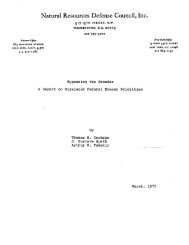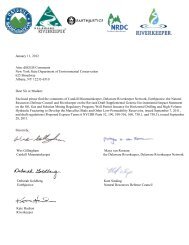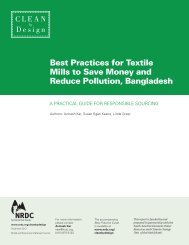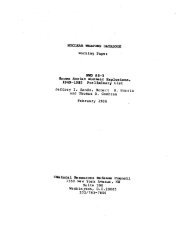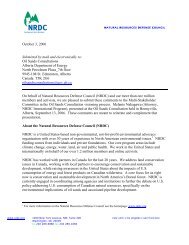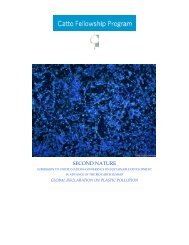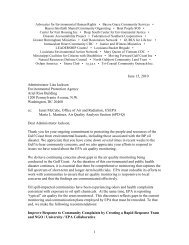A Common Vision for Environmentally Sustainable Seafood - NRDC ...
A Common Vision for Environmentally Sustainable Seafood - NRDC ...
A Common Vision for Environmentally Sustainable Seafood - NRDC ...
Create successful ePaper yourself
Turn your PDF publications into a flip-book with our unique Google optimized e-Paper software.
A <strong>Common</strong> <strong>Vision</strong> <strong>for</strong> <strong>Environmentally</strong> <strong>Sustainable</strong> <strong>Seafood</strong><br />
Ratified by: Blue Ocean Institute, Canadian Parks and Wilderness Society, David Suzuki Foundation,<br />
Ecology Action Centre, Environmental Defense Fund, FishChoice, FishWise, Living Oceans Society, Monterey<br />
Bay Aquarium, Natural Resources Defense Council, New England Aquarium, Ocean Conservancy, Sierra Club<br />
British Columbia, World Wildlife Fund – US<br />
We envision a future where environmentally sustainable fisheries and aquaculture (or fish farming) thrive along<br />
with the communities that depend on them. We envision diverse and productive fisheries and aquaculture<br />
systems that deliver seafood on a continuing basis as well as vital environmental benefits necessary <strong>for</strong> the<br />
well-being of all the world’s inhabitants.<br />
The seafood industry can be a powerful <strong>for</strong>ce <strong>for</strong> improving the environmental sustainability of seafood and<br />
ocean ecosystems. We envision a future in which businesses that buy and sell seafood and conservation<br />
organizations are active partners helping to achieve sustainable fisheries management and aquaculture<br />
production. We believe that this partnership is one of the critical elements to achieving the long-term viability of<br />
the seafood supply that is essential <strong>for</strong> business and that we all depend on as a global community.<br />
We invite businesses to join us in realizing this vision.<br />
The Need <strong>for</strong> Sustainability Improvements<br />
With growing seafood demand, improving the sustainability of wild-caught and farmed seafood is necessary to<br />
protect our oceans and seafood supplies into the future.<br />
As population increases, global demand <strong>for</strong> seafood rises. According to the Food and Agriculture Organization<br />
of the United Nations, by 2030 there will be a need <strong>for</strong> an additional 40 million tons of seafood. Currently, wildcaught<br />
fish make up 57 percent of the seafood consumed, but the amount of wild fish caught is unlikely to<br />
increase since most fisheries are fished at or beyond capacity. Current fishing practices can also harm ocean<br />
ecosystems by destroying seafloor habitats and killing seabirds, marine mammals, and sea turtles.<br />
To meet the demand <strong>for</strong> seafood, aquaculture has expanded greatly, increasing 86 percent in the last decade.<br />
While some <strong>for</strong>ms of aquaculture hold promise as sustainable options to meet seafood demand, the practices<br />
used to farm many species can result in the loss of natural habitat, release of waste, spread of disease, and<br />
the introduction of <strong>for</strong>eign species that harm native fish. Also troubling is the dependence on wild-caught fish to<br />
feed many farmed species, a practice that puts added strain on the world’s oceans.
Call <strong>for</strong> Action<br />
We invite businesses that buy and sell seafood to work with the conservation community to build a sustainable<br />
future <strong>for</strong> seafood. We urge such businesses to advance the sustainability of fishing and aquaculture by<br />
choosing to buy environmentally responsible products and through direct support <strong>for</strong> policies and practices that<br />
protect the oceans and the long-term viability of our seafood supply.<br />
We recognize that fulfilling the vision <strong>for</strong> environmental sustainability is a journey involving many steps. We<br />
seek to combine industry’s business knowledge and ability to innovate with our conservation expertise. We call<br />
upon seafood businesses to move <strong>for</strong>ward with us on the path toward sustainability through the following<br />
actions:<br />
Make a Commitment<br />
Commit to developing and implementing a comprehensive, corporate policy on<br />
sustainable seafood.<br />
Collect Data<br />
Assess and monitor the environmental sustainability of your seafood products.<br />
Buy <strong>Environmentally</strong> Responsible <strong>Seafood</strong><br />
Support environmentally responsible seafood choices through purchasing decisions.<br />
Be Transparent<br />
Make in<strong>for</strong>mation regarding your seafood products publicly available.<br />
Educate<br />
Educate your customers, suppliers, employees and other key stakeholders about<br />
environmentally responsible seafood.<br />
Support Re<strong>for</strong>m<br />
Engage in and support policy and management re<strong>for</strong>m that leads to positive<br />
environmental outcomes in fisheries and aquaculture management.<br />
2
Steps to Achieve a <strong>Common</strong> <strong>Vision</strong> <strong>for</strong> <strong>Environmentally</strong> <strong>Sustainable</strong> <strong>Seafood</strong><br />
The <strong>Common</strong> <strong>Vision</strong> <strong>for</strong> <strong>Environmentally</strong> <strong>Sustainable</strong> <strong>Seafood</strong> identifies six critical areas where seafood<br />
companies can demonstrate environmental leadership and take action to ensure a sustainable seafood supply.<br />
Specific actions to meet and address these areas are outlined below.<br />
Commitment<br />
Creating a public corporate policy on sustainable seafood shows an important commitment to action and<br />
provides essential guidance <strong>for</strong> company practices. A comprehensive sustainable seafood policy would:<br />
• Establish a corporate philosophy and approach to achieving the <strong>Common</strong> <strong>Vision</strong> <strong>for</strong> <strong>Sustainable</strong><br />
<strong>Seafood</strong>.<br />
• Outline specific activities to address the critical areas of data collection, transparency, procurement,<br />
education and re<strong>for</strong>m.<br />
• Identify specific goals and targets to be achieved over set timelines in each area.<br />
Data Collection<br />
Detailed data collection on seafood products is critical to protecting the long-term supply of seafood. A greater<br />
understanding of products and where they come from enables environmentally responsible companies to<br />
measure changes in the seafood supply, identify problems, and take action to improve supply over time.<br />
Specific in<strong>for</strong>mation that is essential to collect and monitor over time includes:<br />
• <strong>Common</strong> and scientific names.<br />
• Country of origin.<br />
• The stock from which the seafood was caught or the farm from which it was cultivated.<br />
• Fishing gears or aquaculture production methods used.<br />
• Producers and/or processors.<br />
• Volume of product purchased.<br />
• Environmental responsibility ranking (i.e., how each product is ranked by leading conservation NGOs<br />
on environmental per<strong>for</strong>mance.)<br />
Procurement<br />
<strong>Seafood</strong> companies can make a significant difference and demonstrate environmental leadership by making<br />
changes in their buying practices. <strong>Environmentally</strong> responsible companies:<br />
• Preferentially sell environmentally responsible seafood which address local, regional, and global<br />
concerns regarding environmental per<strong>for</strong>mance.<br />
• Stop selling seafood products with serious ongoing environmental impacts.<br />
• If purchasing less sustainable seafood, source from operators that are willing to work proactively to<br />
improve the environmental per<strong>for</strong>mance of fisheries or farms and can demonstrate significant progress<br />
in fixing problems by meeting clear milestones and deadlines <strong>for</strong> improvement.<br />
• Phase out fisheries, producers, and suppliers that refuse to improve their environmental per<strong>for</strong>mance.<br />
3
Transparency<br />
Being transparent about actions taken to achieve the <strong>Common</strong> <strong>Vision</strong> <strong>for</strong> <strong>Sustainable</strong> <strong>Seafood</strong> is essential <strong>for</strong><br />
ensuring industry-wide improvements over time. A transparent, environmentally responsible seafood company<br />
would:<br />
• Make their sustainable seafood policy publicly available.<br />
• Release an annual status report that summarizes goals achieved and identifies planned actions.<br />
• Make sustainability in<strong>for</strong>mation (i.e., common and scientific name, 1 catch area or farm, country of origin,<br />
catch gear or farm technique used, environmental responsibility ranking) regarding their seafood<br />
products easily accessible to customers and other interested parties. This includes:<br />
o In-store labels on their products. 2<br />
o In<strong>for</strong>mation shared via their Web site.<br />
o In-store signage or collateral materials.<br />
o Other marketing or outreach materials.<br />
Education<br />
Educating customers and key stakeholders along the seafood supply chain will increase understanding of<br />
sustainability. <strong>Environmentally</strong> responsible seafood companies:<br />
• Train management and employees about issues of environmentally responsible seafood.<br />
• Prepare sales staff to help customers choose environmentally responsible seafood selections.<br />
• Share educational materials (e.g., signs, brochures, Web content) with customers about the status of<br />
the world’s ocean life and key environmental criteria.<br />
• Ensure suppliers are aware of environmental issues with seafood and equipped to address key<br />
concerns.<br />
Re<strong>for</strong>m<br />
To achieve the <strong>Common</strong> <strong>Vision</strong> <strong>for</strong> <strong>Sustainable</strong> <strong>Seafood</strong> significant improvements in environmental<br />
per<strong>for</strong>mance of fisheries and farming operations are required. There are multiple ongoing activities to<br />
encourage these changes as well as the need to identify and address many other potential improvements.<br />
Active engagement in policy and management re<strong>for</strong>m includes, but is not limited to:<br />
• Advocating <strong>for</strong> national and international fisheries and aquaculture policies and management to be<br />
more environmentally responsible.<br />
• Supporting ef<strong>for</strong>ts to collaborate across industry and conservation organizations to develop strong<br />
per<strong>for</strong>mance based metrics and high standards to tackle existing issues in wild and farmed seafood. A<br />
promising multi-stakeholder, transparent process underway <strong>for</strong> the development of aquaculture<br />
standards is the Aquaculture Dialogues.<br />
• Working with suppliers or producers to improve and document environmental per<strong>for</strong>mance.<br />
o For wild-caught seafood, work with suppliers and producers to move producer practices to<br />
meet environmentally responsible standards or credible certification. 3 Set benchmarks to verify<br />
improvement.<br />
o For farmed seafood that is not certified under a credible eco-label, require that suppliers<br />
provide annual, third-party verified data which clarifies their farm's per<strong>for</strong>mance in addressing<br />
the key impacts of the species they are farming (see attached Key Impacts of <strong>Common</strong>ly<br />
Farmed Fish), and make nonproprietary data publicly available.<br />
1 Approved names are available from the US Federal Drug Administration and the Canadian Federal Inspection Agency.<br />
2 <strong>Seafood</strong> should only be labeled organic if it meets the USDA organic standard in the US, or the Canadian federal standard in Canada.<br />
3 If committed to an eco-label <strong>for</strong> certified seafood, environmentally responsible companies ensure that the eco-label con<strong>for</strong>ms to international standards<br />
<strong>for</strong> third party certification (e.g. ISEAL and FAO guidelines on governance and standard setting) and upholds strong environmental standards.<br />
4



